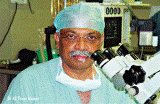Health Topics
-
Healthy Living
-
|
|
March 2010
|
| Hearing Difficulties |
| Dr E C Vinaya Kumar |
| |
 |
In a considerable number of cases, a hearing difficulty starts so gradually that the sufferer is not quite aware of it. As it progresses, there is difficulty in understanding speech which they may progressively be unable to hear. |
No one has ever been able to identify the reason why some people in their early fifties have hearing difficulty, yet others have little or no difficulty even in their late 70s or even in their 80s! Genetic factors may play a part though. To understand a little about hearing difficulty, it is necessary to know more about the human ear.
The Human Ear
The particular shape of the human ear has been designed by nature to receive the human voice with maximum efficiency. It completely differs from the shape of the ear of a dog, or elephant or bird. Even the shape of the head plays a part! Shape and size almost literally tune and boost certain speech sounds (approx. 3000 to 4000 vibrations or cycles per second, written as a frequency). Due to resonance, the ear canal also boosts or amplifies these frequencies to improve clarity. These frequencies carry the meaningful information of speech.
At the end of the ear canal is a membrane called the eardrum. It will surprise most people to know that even if there is a hole in it, most hearing is not lost. Even if the entire eardrum is missing, a person can still hear, but it will be reduced by about 40 dB or 40 degrees of hearing.
Attached to the drum is a chain of three tiny bones, the last of which is called the stirrup. This chain of bones is intended by nature to form a kind of mechanical lever system, to convert the minute air vibrations of sound to mechanical movements. This entire system, along with the drum, is called the middle ear.
The stirrup sits on a small oval window of a very tiny snail like organ, which contains fluid. In the fluid is a membrane on which there are approximately 30,000 hair cells, which communicate with the nerve of hearing, which goes to the brain.
Hair Cells
The minute air vibrations are thus carried to the fluid, which agitates the corresponding hair cells. These hair cells play a crucial part in hearing, as they communicate to the brain the different sounds, after virtually analysing and sorting them out. It is exactly at this point that the hearing difficulty of advancing age starts. As more of these hair cells degenerate or die due to age, the more the hearing loss progresses.
At the start, the sharp or high frequency sounds begin to lose their intensity. Words containing weak consonants and fricatives i.e. sounds which do not use the vocal cords, such as “ss, sh, ch, ph, th†gradually become difficult to identify. As you grow older, the problem becomes worse.
Hearing Aids
In the olden days, say around the time when India received independence, hearing aids were clumsy and bulky, and carried in the pocket. They picked up and amplified more background noises than speech, and could not quite provide the clarity required for old age nerve loss.
Today, space age technology has helped to produce hearing aids, which are as small as the last digit of your little finger! They sit at the ear canal entrance, are skin coloured and hence, almost invisible. They have no wires or tubes outside the ear canal, yet are complete with on/off and volumecontrol switches. These aids utilise the natural amplification offered by the convolutions and shape of the ear and pick up sound. They amplify the weak consonants and fricatives and help in hearing clearly.
Being evolved from space age technology with components derived from those used by astronauts, they are extremely rugged, have a very wide frequency response for clarity, can withstand much more rough use and have a much longer life than pocket or behind the ear hearing aids.
Deprivation Effect
Anyone with hearing loss of over 40 decibels average (40 degrees of hearing) in both ears, should use a hearing aid. If only one ear is fitted, the other ear suffers the deprivation effect, as researchers call it. Hence, both the ears should be fitted with a hearing aid. Fitting both ears also provides almost natural hearing in all situations. This includes identification of direction and distance of sound; it also offers selective hearing (when many people are talking or while watching TV).
There are cases where the hearing loss is way over what the best of hearing aids can rectify. In such cases, a cochlear implant is surgically implanted. This electronic device provides a sense of sound even to those who are profoundly deaf. This implant is also known as a bionic ear. |
 |
Dr. E C Vinaya Kumar, ENT Surgeon at Apollo Health City, Hyderabad |
|
|